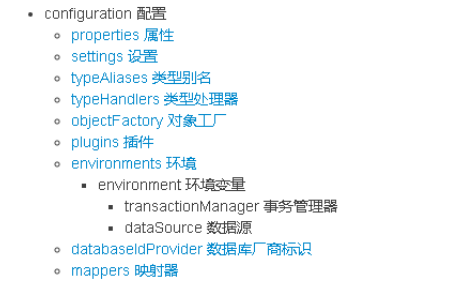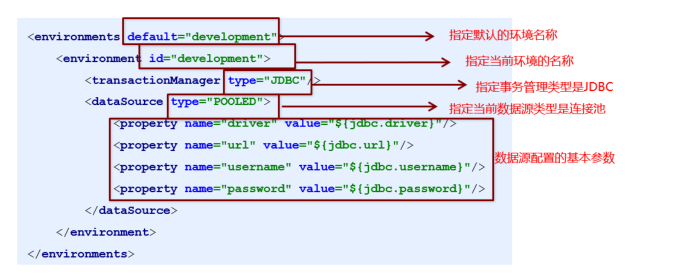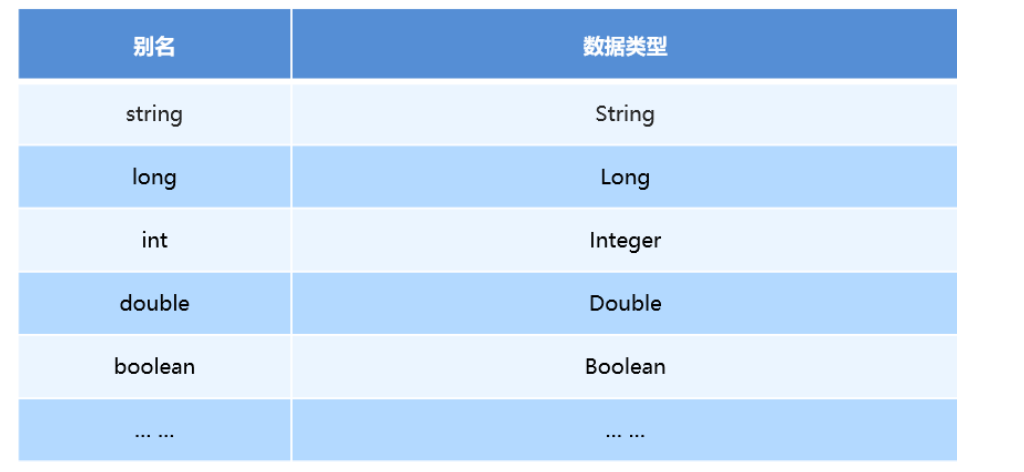1.核心配置文件SqlMapConfig.xml
1.1 MyBatis核心配置文件层级关系

1.2MyBatis常用配置解析
1)environments标签

其中,事务管理器(transactionManager)类型有两种:
- JDBC:这个配置就是直接使用了JDBC 的提交和回滚设置,它依赖于从数据源得到的连接来管理事务作用域。
- MANAGED:这个配置几乎没做什么。它从来不提交或回滚一个连接,而是让容器来管理事务的整个生命周期(比如 JEE 应用服务器的上下文)。 默认情况下它会关闭连接,然而一些容器并不希望这样,因此需要将
closeConnection 属性设置为 false 来阻止它默认的关闭行为
其中,数据源(dataSource)类型有三种:
- UNPOOLED:这个数据源的实现只是每次被请求时打开和关闭连接。
- POOLED:这种数据源的实现利用“池”的概念将 JDBC 连接对象组织起来。
- JNDI:这个数据源的实现是为了能在如 EJB 或应用服务器这类容器中使用,容器可以集中或在外部配置数据源,然后放置一个 JNDI 上下文的引用。
2)mapper标签
该标签的作用是加载映射的,加载方式有如下几种:
//使用相对于类路径的资源引用,例如:
<mapper resource="org/mybatis/builder/AuthorMapper.xml"/>
//使用完全限定资源定位符(URL),例如:
<mapper url="file:///var/mappers/AuthorMapper.xml"/>
//使用映射器接口实现类的完全限定类名,例如:
<mapper class="org.mybatis.builder.AuthorMapper"/>
//将包内的映射器接口实现全部注册为映射器,要求和mapper同包同名 例如:
<package name="org.mybatis.builder"/>
3)Properties标签
实际开发中,习惯将数据源的配置信息单独抽取成一个properties文件,该标签可以加载额外配置的properties文件
jdbc.properties
jdbc.driver=com.mysql.jdbc.Driver
jdbc.url=jdbc:mysql:///test
jdbc.username=root
jdbc.password=123456
SqlMapConfig.xml
<?xml version="1.0" encoding="UTF-8"?>
<!DOCTYPE configuration
PUBLIC "-//mybatis.org//DTD Config 3.0//EN"
"http://mybatis.org/dtd/mybatis-3-config.dtd">
<configuration>
<!--加载外部properties-->
<properties resource="jdbc.properties"></properties>
<environments default="development">
<environment id="development">
<!--当前事务交给JDBC处理-->
<transactionManager type="JDBC"/>
<!--当前使用mybatis提供的连接池-->
<dataSource type="POOLED">
<property name="driver" value="com.mysql.jdbc.Driver"/>
<property name="url" value="jdbc:mysql:///test"/>
<property name="username" value="root"/>
<property name="password" value="123456"/>
</dataSource>
</environment>
</environments>
<!--引入映射配置文件-->
<mappers>
<mapper resource="UserMapper.xml"/>
<mapper resource="UserMapperProxy.xml"/>
</mappers>
</configuration>
4)typeAliases标签
类型别名是为Java 类型设置一个短的名字。原来的类型名称配置如下 **
**
配置typeAliases,为com.cookie.pojo.User定义别名为user
<?xml version="1.0" encoding="UTF-8"?>
<!DOCTYPE configuration
PUBLIC "-//mybatis.org//DTD Config 3.0//EN"
"http://mybatis.org/dtd/mybatis-3-config.dtd">
<configuration>
<!--加载外部properties-->
<properties resource="jdbc.properties"></properties>
<!--给实体类的全限定类名起别名-->
<typeAliases>
<typeAlias type="com.cookie.pojo.User" alias="user"></typeAlias>
</typeAliases>
<environments default="development">
<environment id="development">
<!--当前事务交给JDBC处理-->
<transactionManager type="JDBC"/>
<!--当前使用mybatis提供的连接池-->
<dataSource type="POOLED">
<property name="driver" value="com.mysql.jdbc.Driver"/>
<property name="url" value="jdbc:mysql:///test"/>
<property name="username" value="root"/>
<property name="password" value="123456"/>
</dataSource>
</environment>
</environments>
<!--引入映射配置文件-->
<mappers>
<mapper resource="UserMapper.xml"/>
<mapper resource="UserMapperProxy.xml"/>
</mappers>
</configuration>
<?xml version="1.0" encoding="UTF-8" ?>
<!DOCTYPE mapper
PUBLIC "-//mybatis.org//DTD Mapper 3.0//EN"
"http://mybatis.org/dtd/mybatis-3-mapper.dtd">
<mapper namespace="com.cookie.mapper.UserMapper">
<!--namespace :命名空间:与id组成sql的唯一标识-->
<!--resultType:表明返回值类型-->
<select id="findAll" resultType="user">
select * from user
</select>
<!--添加-->
<insert id="add" parameterType="user">
insert into user values(#{id},#{username},#{password})
</insert>
<!--修改-->
<update id="update" parameterType="user">
update user set username = #{username},password = #{password} where id = #{id}
</update>
<!--删除-->
<delete id="delete" parameterType="java.lang.Integer">
delete from user where id = #{id}
</delete>
</mapper>
<!--给实体类的全限定类名起别名-->
<typeAliases>
<!--给单独的实体起别名-->
<typeAlias type="com.cookie.pojo.User" alias="user"></typeAlias>
<!--给包下所有类起别名 不区分大小写-->
<package name="com.cookie.pojo"/>
</typeAliases>
上面是自定义的别名, mybatis框架已经设置好的一些常用的类型的别名:
2.映射配置文件mapper.xml

动态sql语句概述:
Mybatis 的映射文件中,前面的 SQL 都是比较简单的,有些时候业务逻辑复杂时,SQL是动态变化
的,此时前面的 SQL 就不能满足要求了。
官方文档,描述如下: 
动态 SQL 之
根据实体类的不同取值,使用不同的 SQL语句来进行查询。比如在 id如果不为空时可以根据id查询,如果username 不同空时还要加入用户名作为条件。这种情况在多条件组合查询中经常会碰到。
<select id="findByCondition" parameterType="user" resultType="user">
select * from user where 1=1
<if test="id != 3">
and id = #{id}
</if>
<if test="username != null">
and username = #{username}
</if>
</select>
能行但是不太好,用标签
<select id="findByCondition" parameterType="user" resultType="user">
select * from user
<where>
<if test="id != 3">
and id = #{id}
</if>
<if test="username != null">
and username = #{username}
</if>
</where>
</select>
public interface UserMapper {
List<User> findAll();
List<User> findByCondition(User user);
}
@Test
public void testProxy2() throws IOException {
InputStream resourceAsStream = Resources.getResourceAsStream("SqlMapConfig.xml");
SqlSessionFactory sqlSessionFactory = new SqlSessionFactoryBuilder().build(resourceAsStream);
SqlSession sqlSession = sqlSessionFactory.openSession();
UserMapper mapper = sqlSession.getMapper(UserMapper.class);
User newUser = new User();
newUser.setId(3);
newUser.setUsername("cookie");
List<User> users = mapper.findByCondition(newUser);
for (User user : users) {
System.out.println(user);
}
}
动态 SQL 之
循环执行sql的拼接操作,例如: SELECT * FROM USER WHERE id IN (1,2,5)。
<select id="findByIds" parameterType="list" resultType="user">
select * from user
<where>
<foreach collection="list" open="id in (" close=")" item="id" separator=",">
#{id}
</foreach>
</where>
</select>
public interface UserMapper {
List<User> findAll();
List<User> findByCondition(User user);
List<User> findByIds(List<Integer> list);
}
@Test
public void testProxy3() throws IOException {
InputStream resourceAsStream = Resources.getResourceAsStream("SqlMapConfig.xml");
SqlSessionFactory sqlSessionFactory = new SqlSessionFactoryBuilder().build(resourceAsStream);
SqlSession sqlSession = sqlSessionFactory.openSession();
UserMapper mapper = sqlSession.getMapper(UserMapper.class);
List<Integer> list = new ArrayList<>();
list.add(3);
list.add(2);
List<User> users = mapper.findByIds(list);
for (User user : users) {
System.out.println(user);
}
}
foreach标签的属性含义如下:
标签用于遍历集合,它的属性:
- collection:代表要遍历的集合元素,注意编写时不要写#{}
- open:代表语句的开始部分
- close:代表结束部分
- item:代表遍历集合的每个元素,生成的变量名
- sperator:代表分隔符
SQL片段抽取
Sql 中可将重复的 sql 提取出来,使用时用 include 引用即可,最终达到 sql 重用的目的
<?xml version="1.0" encoding="UTF-8" ?>
<!DOCTYPE mapper
PUBLIC "-//mybatis.org//DTD Mapper 3.0//EN"
"http://mybatis.org/dtd/mybatis-3-mapper.dtd">
<mapper namespace="com.cookie.mapper.UserMapper">
<!--namespace :命名空间:与id组成sql的唯一标识-->
<!--resultType:表明返回值类型-->
<!--抽取sql片段简化编写-->
<sql id="selectUser">
select * from user
</sql>
<select id="findAll" resultType="user">
<include refid="selectUser"></include>
</select>
<!--添加-->
<insert id="add" parameterType="user">
insert into user values(#{id},#{username},#{password})
</insert>
<!--修改-->
<update id="update" parameterType="user">
update user set username = #{username},password = #{password} where id = #{id}
</update>
<!--删除-->
<delete id="delete" parameterType="java.lang.Integer">
delete from user where id = #{id}
</delete>
<select id="findByCondition" parameterType="user" resultType="user">
<include refid="selectUser"></include>
<where>
<if test="id != 3">
and id = #{id}
</if>
<if test="username != null">
and username = #{username}
</if>
</where>
</select>
<select id="findByIds" parameterType="list" resultType="user">
<include refid="selectUser"></include>
<where>
<foreach collection="list" open="id in (" close=")" item="id" separator=",">
#{id}
</foreach>
</where>
</select>
</mapper>






















 1595
1595











 被折叠的 条评论
为什么被折叠?
被折叠的 条评论
为什么被折叠?








